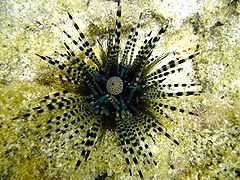Echinothrix calamaris
| Double spined urchin | |
|---|---|
 | |
| Scientific classification | |
| Kingdom: | Animalia |
| Phylum: | Echinodermata |
| Class: | Echinoidea |
| Order: | Diadematoida |
| Family: | Diadematidae |
| Genus: | Echinothrix |
| Species: | E. calamaris |
| Binomial name | |
| Echinothrix calamaris Pallas, 1774 | |
Echinothrix calamaris, known commonly as the banded sea urchin or double spined urchin among other vernacular names, is a species of sea urchin in the family Diadematidae.
Distribution & habitat
The Banded sea urchin is widespread throughout the tropical waters of the Indo-Pacific region, from eastern coast of Africa to French Polynesia, including Hawaii and the Red Sea. [1][2]
It occurs from the surface to 70 centimetres (2.3 ft) depth and can be found in lagoons, external reef slopes and channels.[1]
Description
The Banded sea urchin has a test (shell) diameter of about 5 cm.[1] It has two sets of spines, shorter closed spines which are going from yellow to dark in colour and can deliver a nasty sting, and longer open ended spines that are often banded with light and dark colour.[3]
Behaviour
This sea urchin is active at night, hiding in crevices or under rocks during the day.[1]
Miscellaneous notes
Many juvenile fish of the family Apogonidae (cardinal fish) may hide in the spines for protection.[1]
Confusion may occurs between Echinothrix calamaris and young Diadema setosum or Diadema savigny when these two latter have banded spines. However, these two species have only one kind of spines which are longer and finer.[1]
In Hawaii, E. calamaris is often host to a symbiotic crab, Echinoecus pentagonus.[4]
References
- ↑ 1.0 1.1 1.2 1.3 1.4 1.5 Le Bris, Sylvain; Maran, Vincent (2010-11-27). "Echinothrix calamaris (Pallas, 1774)". DORIS. Retrieved 2013-11-23.
- ↑ Encyclopedia of Life
- ↑ Echinothrix calamaris
- ↑ John P. Hoover (2007). Hawaiian Sea Creatures. Mutual Publishing. ISBN 1-56647-220-2.